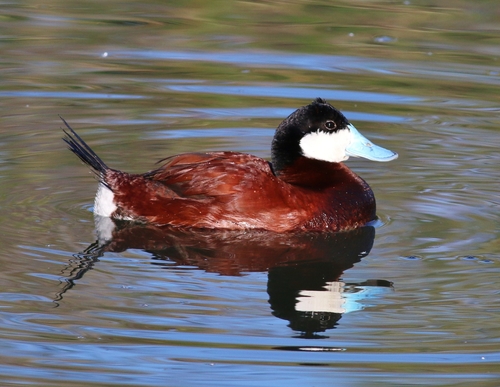
Ruddy Duck
The Ruddy Duck (*Oxyura jamaicensis*) is a small, compact duck known for its distinctive bright blue bill and chestnut-red body in breeding males. Native to North and South America, it has also been introduced to Europe, where it has become a controversial species due to hybridization concerns with the native White-headed Duck. Ecologically, Ruddy Ducks play a role in wetland ecosystems, primarily feeding on aquatic invertebrates and plant matter, and serving as prey for larger predators. They are known for their elaborate courtship displays, showcasing the males' unique features.
35-43 cm
Length
55-60 cm
Wingspan
Least Concern
Conservation Status
Distribution
Native to North America and South America, ranging from Canada to the southern tip of South America. Introduced populations are established in Europe, particularly in the United Kingdom. They are partially migratory, with northern populations moving south for the winter.
Lifespan
Average lifespan in the wild is 2-3 years, but they can live up to 13 years in captivity.
Ruddy Duck's Habitat
Habitat Types
Freshwater marshes, Ponds, Lakes, Slow-moving rivers, Coastal lagoons
Climate Zones
Temperate, Subtropical, Tropical
Adaptations
Ruddy Ducks possess dense, waterproof plumage for insulation in cold water. Their legs are set far back on their bodies, which aids in diving but makes them awkward on land. They have a relatively large bill for sifting through mud and vegetation for food.
Variations
Three subspecies are generally recognized: *O. j. jamaicensis* (North America), *O. j. andina* (Colombia), and *O. j. ferruginea* (Andes).
Appearance
Breeding Plumage
Breeding males have a chestnut-red body, a bright blue bill, a black cap, and a white cheek patch. Non-breeding males and females are mostly grayish-brown with a darker cap and a paler cheek patch.
Seasonal Feather Changes
Males undergo a complete molt after the breeding season, losing their bright colors and resembling females. They regain their breeding plumage in the late winter or early spring.
Sex Based Plumage Differences
Significant sexual dimorphism is present, especially during the breeding season.
Notable Features
Bright blue bill (breeding males), Stiff, erect tail feathers, Compact body shape
Diet and Feeding
Primary Foods
Aquatic invertebrates (insect larvae, crustaceans, mollusks), Seeds, Aquatic plants (pondweeds, sedges)
Foraging Behavior
Ruddy Ducks are diving ducks, typically foraging by diving underwater and sifting through mud and sediment at the bottom. They also dabble at the surface.
Specializations
Their relatively large bill is adapted for straining small food items from the water and sediment.
Seasonal Diet Variations
Diet may shift slightly depending on food availability, with a greater reliance on seeds and plant matter during the winter months when invertebrates are less abundant.
Behavior
Social Structure
Generally solitary or in pairs during the breeding season. Forms larger flocks during migration and winter.
Communication
Drumming sounds (males during courtship), Soft quacks and grunts, Visual displays (head and tail movements)
Migration
Northern populations are migratory, moving south to ice-free areas for the winter. Southern populations may be resident or undertake shorter, local movements.
Territorial or Group Behaviors
Males are territorial during the breeding season, defending their nesting area from other males. Outside of the breeding season, they are generally non-territorial.
Conservation
Threats
Habitat loss and degradation (wetland drainage), Hunting (in some regions), Hybridization with the endangered White-headed Duck (in Europe), Lead poisoning (from ingestion of spent lead shot)
Protection Programs
Wetland conservation and restoration efforts, Hunting regulations
Local National Laws
Protected under the Migratory Bird Treaty Act in the United States and Canada. Culling programs exist in Europe to control introduced populations.
Population Trend
Stable
Population Estimates
The global population is estimated to be around 730,000 - 1,200,000 individuals.
Interesting Facts
Ruddy Ducks are known for laying some of the largest eggs relative to their body size among all ducks.
This is thought to be an adaptation to produce precocial young that are well-developed at hatching.
The introduced population in Europe is a threat to the endangered White-headed Duck.
Ruddy Ducks hybridize with White-headed Ducks, leading to genetic swamping and reducing the purity of the White-headed Duck gene pool.
Males have a corkscrew-shaped penis, a feature common in some waterfowl species.
This is thought to be related to sperm competition and forced copulation.
Faqs about Ruddy Duck
Why is the male Ruddy Duck's bill blue?
The bright blue color of the bill is a result of structural coloration, caused by the arrangement of keratin and air pockets within the bill. It is thought to play a role in mate attraction.
Are Ruddy Ducks aggressive?
Males can be aggressive during the breeding season, defending their territory and mates. Outside of the breeding season, they are generally less aggressive.
What is the difference between a Ruddy Duck and a White-headed Duck?
White-headed Ducks are larger, have a white head (as the name suggests), and a different bill shape. Ruddy Ducks have a chestnut-red body in breeding plumage.
Copyright @ Nature Style Limited. All Rights Reserved.
 English
English